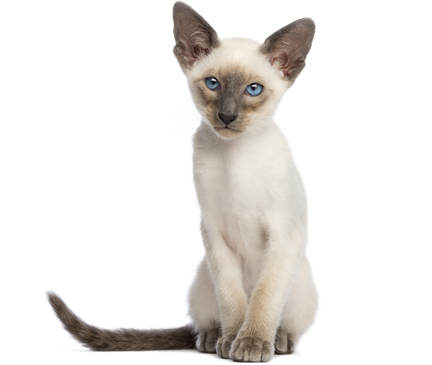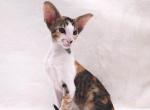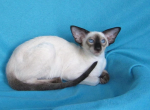

Oriental Cat Breed Description
Oriental Traits At A Glance
Active
Playful
Requires Attention
Affectionate
Vocal
Docile
Intelligent
Independent
Health
Grooming
Child Friendly
Pet Friendly
Hypoallergenic
Size: Oriental cats are medium in size and weigh between 5 to 12 pounds.
Characteristics: The general appearance of the Oriental is identical to the Siamese aside from coat color. Orientals have long, slender yet muscular bodies with fine bones. Their lean and svelte bodies lend themselves well to athleticism and activity. Their legs are long and skinny and their hind legs are longer than their front legs. Their necks are very long as well and sitting atop their long necks are long, wedge-shaped heads. Their ears are a very large and pointed and their eyes are medium-sized and almond shaped.
Temperament: Their bodies are dead giveaways for their personalities. They have athletic bodies and they like to use them and their vibrant and colorful coats are as vibrant and colorful as their personalities. They love to show off their athletic ability by climbing and jumping to great heights. They also enjoy playing with toys and can make many ordinary things into toys to amuse themselves. They are incredibly social and active and do not love to be left alone for long periods of time. They will be your best friend and will demand your attention. When these social cats are not talking your ear off, they will want to be in the middle of everything you are doing. Orientals may be demanding, but they will quickly become your best friend. They are incredibly loyal and affectionate and will gladly sit in your lap and be petted. While they do love to snuggle, if you are looking for a lap cat, an Oriental may not be the right cat for you. They will love you and show affection, but they are also very active and love to be the center of attention. They will do just about anything to be adored and you will find it easy to adore them!
Care: Grooming your Oriental cat is relatively easy. For shorthairs, they simply need to be combed once per week to keep their short coat looking glossy and lovely. For longhairs, brush their hair 2 to 3 times each week to prevent shedding, tangles and matting. Additionally, clean their ears and trim their nails as needed. Lastly, be sure to brush their teeth often so prevent periodontal disease and keep their pearly whites shining!
Coat: Orientals have both shorthair and longhair coats. Their coat is fine, glossy, smooth and close-lying. They come in hundreds of colors and patterns and have been given the nickname "Ornamentals" because of their varied and beautiful range coat colors as well as their long tail. If you are looking for a hypoallergenic cat then the Oriental shorthair cat is a great candidate. They produce less of the Fel D1 protein which is the true cause for your allergic reaction. There is no cat that is 100% allergy free so increasing the frequency of grooming and bathing your furry friend will also help.
Origin: The history of the Oriental cat breed actually begins with a Siamese cat. The Siamese cat is one of the oldest cats in the world and was mentioned as early as sometime between 1350 C.E, and 1767 C. E. in The Cat-Book Poems, an early manuscript. The breed has been loved for centuries and became a popular cat breed among fanciers. Originally, Siamese cats were allowed to be brown, blue or bi-colored. But, it was determined by Britain's Siamese Cat Club in the 1920s that the Siamese cat breed would no longer allow blue colored coats for Siamese cats.
When it was determined that blue colored Siamese cats would no longer be accepted, focus was pulled from this particular coat color and the World War II hit. When World War II happened, many cat breeds suffered and faced extinction. After the war, interest was renewed in the breed and many breeders still had an interest in the beautiful cats. In the 1950s and 1960s, breeders began to create a hybrid cat that was a cross between a Siamese cat and Russian Blues, Abyssinians and domestic shorthairs. Breeders loved the look and body type of the Siamese, but wanted a wider variety of colors and patterns.
Within a few generations of breeding, the look they had desired was achieved and it did not take long for American breeders to become intrigued by the beautiful cats. In the late 1960s, American breeders began to breed cats as the British breeders had to achieve the same results of Siamese appearance with a variety of colors and patterns. While some Siamese breeders were not initially keen to the idea of a Siamese hybrid, the breed quickly grew in popularity. By 1972, the Oriental Shorthairs were accepted by the CFA for registration., a relatively short amount of time from initial conception!
Then, in 1977, the breed was granted championship status and very quickly became one of the CFA's most popular breeds among fanciers. And, in continuing with the theme of offering variety, breeders decided they wanted to create a an Oriental but with a long coat. And thus, the Oriental Longhair was developed in the late 1970s. The longhair variety rapidly grew in popularity and were accepted for registration by the CFA in 1988.
But later, in 1995, the breed experienced some changed yet again. The CFA determined that the breed would no longer be separated by shorthair and longhair and that they would just be known as Oriental cats. It was also determined that Orientals with bi-color coats would be accepted as well. These two decisions immensely increased the number of Orientals that could compete in cat shows and the breed has continued to grow and enjoy success ever since.


